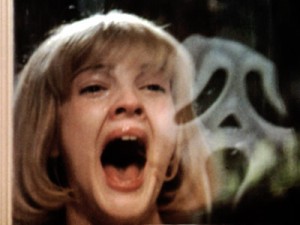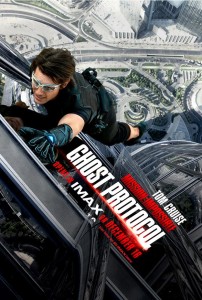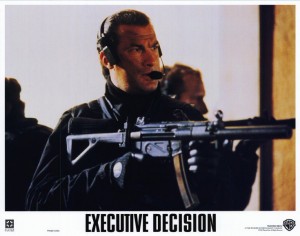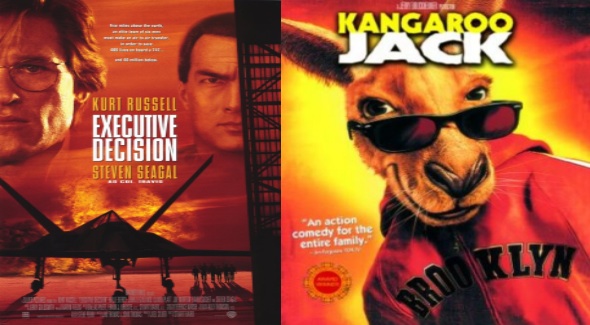Please enjoy this post from frequent guest author Ben Adams.
In the seminal work The Ghost Ship Moment, Matt Belinkie makes the following observation:
…certain movies are divided into two parts: the part before the characters know what kind of movie they’re in, and the part after. The Ghost Ship Moment (or GSM), in its most basic formulation, is when the characters in a film learn what you know…
The Ghost Ship Moment relies on a gap in information between the audience and the protagonists—though the teenagers on screen are excited about going to the lake for a weekend of alcohol and fornication, the audience is excited for the violence to start. After the first body falls out of a tree, the teenagers catch up to the audience and realize that they are in danger.

However, the gap in knowledge almost never closes entirely. In Ghost Ship, Julianna Marguiles’ character “Maureen Epps” catches up with the audience when she finds out that this ship has g-g-g-ghosts! But the audience still has an advantage: Julianna Marguiles got top billing, and the audience has seen horror movies before, so they know that her character is probably going to be the “last girl.” Despite the dangerous events, the audience is never really expecting her to die. Maureen Epps (the character), though, never knows she’s in a movie; she’s running away from ghosts the whole time, scared of dying at any second.
It is almost impossible to walk into a theater or sit down in front of a TV without at least some prior knowledge. Even if you haven’t seen a trailer, read a review or heard a plot synopsis from a friend, you’re likely familiar with the genre and the well-known actors. All of this combines to create a firm—and usually accurate—set of expectations. We know the Meat-Hook killer is going to kill the arrogant jock, so from a plot standpoint we’re not really interested in the fact that he just got killed; we’re interested in seeing how the characters react to learning what we already know.
On rare occasions this relationship is flipped around. Sometimes the audience’s expectations are inaccurate, and the audience finds out just what kind of movie it is really watching. Whether from deliberate misdirection or poor marketing, the movie that we’re expecting to see can sometimes be very different from the movie that was actually made. It is possible, then, for there to be a Reverse Ghost Ship Moment, where the audience’s prior expectations of a movie are turned around and used against them.
Two specific types of “reverse” Ghost Ship Moments tend to crop up more often than others, and in the spirit of the original Ghost Ship Moment, I’ve chosen to name them after suitably B movies from the late 90’s and early 00’s.
The Actor Bait-and-Switch or “The Executive Decision Moment”
At the opening of Mission Impossible: Ghost Protocol, IMF agent Ethan Hunt is in a dire situation. Imprisoned in Russia, he needs to fight his way through an endless array of hard-ass Russian prisoners and prison guards. The character Ethan Hunt believes that anything could go wrong, and he could get stabbed in the gut at any moment. Of course, we know he really couldn’t—they don’t pay Tom Cruise to get shived in the opening scene of the movie, and there’s no way he’s not going to make it to the final credits sequence.

Ho-hum, I’m sure he’ll be fine.
When we see a top-billed movie star on screen, we generally expect that they are there to stay. If they die, it will certainly be no earlier than the third act, where their passing can be given the appropriate amount of dramatic emphasis. Similarly, we expect that the movie’s “star” will feature prominently in the plot: the guy getting paid $20mil to be there is probably not playing “Checkout Clerk #2.”
Which is why it is so surprising when the audience realizes that the “star” isn’t the star of the movie at all. If you went to see Executive Decision in 1996, you were probably expecting “Die-Hard-on-an-Airplane” starring Steven Seagal as Lieutenant Colonel Austin Travis, killing terrorists and snapping necks with his side-kick Kurt Russell. This expectation works out until about 15 minutes into the movie, when Steven Seagal is killed in a freak stealth-fighter-to-747-mid-air-transfer-accident.
The audience has just hit the “Executive Decision Moment” (EDM), where the face on the poster and in the trailer isn’t hero or villain, he’s just some guy who dies so the heroes have something to fight for later in the movie. Before the EDM, the audience is watching a Steven Segal/Kurt Rusell Movie movie. After the EDM, the audience is watching a Kurt Russell movie (whether or not that’s a good thing is left as an exercise for the reader.)

Sir Not Appearing in this Film
In Executive Decision, the mismatch between the film’s marketing and plot was a conscious decision by the moviemakers to play on the audience’s expectations. In other cases, false expectations are the product of an ex post facto decision made by the film’s marketers. The marketing campaign for 2005’s Stealth played up Jamie Foxx’s role heavily as a result of his 2004 Oscar nomination for Collateral and win for Ray.
Stealth had been filmed well before those successes, so Jamie Foxx, who between filming and release had become the biggest star in the movie, is killed before the halfway point of the movie in a freak stealth-fighter-fighting-an-evil-artificial-intelligence-in-a-narrow-canyon accident.
The actor bait-and-switch can happen in less dramatic ways than stealth-fighter-related death. The trailer for 2011’s Limitless clearly sets up Robert DeNiro as the main nemesis of Bradley Cooper’s medication-enhanced main character.
The movie itself opens in media res with Bradley Cooper deciding whether or not to throw himself off of a high-rise balcony before flashing back to the beginning of the story. If you had seen the trailer, the clear expectation is that DeNiro’s robber-baron banker is going to be the prime driver for whatever trouble Cooper is in at the opening of the movie.
In actuality, DeNiro’s character is primarily a background character until the very end, while the Russian mobster “Gennady” who barely appears in the trailer proves to be the “big bad” of the movie. The confrontation between Cooper and DeNiro shown in the trailer is tacked on to the very end of the film and is resolved with just a handful of lines of exposition.
An Executive Decision Moment isn’t, however, a complete inversion of expectations. It’s surprising that the marketed “stars” of Executive Decision and Stealth are killed so early on, but that’s just a change in the face of the movie, not the shape of it. Executive Decision is still Die-Hard-on-an-Airplane, only with the part of John McClane being played by Kurt Russell instead of Steven Seagal.
Genre Mismatch or “The Kangaroo Jack Moment”
After watching that trailer, anyone going to see Kangaroo Jack would assume that they’re about to see a whimsical kid’s movie in which the sunglass-wearing, sass-talking kangaroo is the star. Meanwhile, over here in reality, the movie is an adult-skewed comedy about Jerry O’Connell trying to recover the money he’s supposed to be delivering to the mob in Australia from a (non-talking/non-magical) kangaroo that runs off with his hooded sweatshirt. The kangaroo only talks for one short scene in which the main character is hallucinating.
At the end of the hallucination scene, the audience has hit their Kangaroo Jack Moment – they’ve realized that that’s it, that’s the only talking kangaroo they’re going to get. They’ve been duped by whichever marketing guru at Warner Brothers decided that the world would only ever to pay to see a movie about a kangaroo that steals a mob courier’s blood money if the kangaroo can also talk for some reason.
The Kangaroo Jack moment is the moment you realize that the movie you’ve paid to see and the movie you are actually seeing are two very different things. This type of complete genre-mismatch isn’t unique to marsupial heist movies.
In this two-minute trailer for Bridge to Terabithia, a solid minute is devoted to talking trees and fantastical creatures. The trailer is clearly trying to sell a high-fantasy action vehicle a la The Lion, the Witch and the Wardrobe. The actual Bridge to Terabithia has only a small handful of scenes with fantasy and action, and all of those scenes are quite explicitly in the imaginations of the main characters—the action sequences are meant only to be representational of the movie’s larger, sadder, story about childhood friendship.
Marley and Me’s trailer uses a combination of “Bad to the Bone” and a series of zany canine hijinks to sell you on a light-hearted family comedy revolving around a dog. Spoiler alert: if you Netflix either Marley and Me or Bridge to Terabithia looking for a light popcorn movie to unwind after a rough day, STOP. JUST STOP. Neither of the movies’ marketing departments got the memo that these movies are made of nothing but pure sorrow and tears.
While there may not be a specific moment that the audience realizes they’ve been had, both of these movies are far, far different movies than what is represented in the previews. As a result, their devastatingly sad endings pack that much more of a gut punch precisely because of the Kangaroo Jack moment.
The Ghost Ship Moment is interesting because it highlights the power of expectation in film—the asymmetry of information between audience and character creates dramatic irony. In a Reverse Ghost Ship Moment, when that gap in information is exploited or subverted, it can have a jarring effect on the audience. Done correctly, it can be powerful, as anyone who’s seen the first season of Game of Thrones can attest. Done incorrectly (as most of the above examples show), it can alienate and confuse the audience.
Ben Adams is a Naval Officer living in Southern California who should probably be using his time more effectively. When he’s not driving warships or fighting pirates, he maintains a blog.

Nice article.
For another example of an Executive Decision moment, see The Hurt Locker, where the biggest star gets blown up in the first scene.
Hitchcock is pretty much the king of this (although Cronenberg could probably give him a run for his money). “The Birds”, for instance, is a romantic comedy for almost an hour before it suddenly (and inexplicably) becomes a disaster movie.
Then there’s Psycho, which pulls both Reverse Ghost Ship moments at the same time–the movie changes from a drama about an ill-advised theft to a horror film at the same moment that the top-billed protagonist is replaced by Mr. Bates (who, if not the protagonist for the whole thing, certainly gets his turn with the baton, and is the center of the rest of the movie after seeming at first like a supporting kook there to show Janet Leigh the error of her ways).
I don’t know if the Hitchcock ones count as ‘Kangaroo Jacks’, because if you look at the advertising of Psycho (novel by Robert Bloch, title is a give-away) and The Birds (“The Birds is coming!”), as well as the director’s reputation for suspense/thrillers, I don’t think even an audience at the time could have walked into those expecting a drama and a romantic comedy respectively.
Does marketing give away too much about our movies? Would you rather walk in to Ghost Ship expecting a Ghost Ship moment, or should the film be titled, “Julianna Marguiles screams a lot”? “Star Wars” is perhaps the perfect title, because it sets up all the exposition you need to enjoy the film. It’s a war… IN SPAAACE! Titles like “Back to the Future” and “Cars” make the broad strokes of the film clear, and any twists and turns are experienced by the characters and audience simultaneously.
I’ve always had a beef with film trailers, because there are many things that can be done wrong. These cardinal sins include showing the last shot of the film. I know that the film “Pirahna” did this, showing a man pulled into the water, which is the last shot of the film. In reality, I’ve pretty much seen the whole film in an extremely condensed format. Any action movie trailer will show a clusterf— of it’s action scenes with some lines of dialogue superimposed over top. These trailers turn me off from a film entirely, mainly because of my expectation of what kind of a film it will likely be.
I’m a big fan of 70’s and 80’s film trailers because of the narrative aspect. Sometimes the trailer shows alot of the plot, possibly the whole first act and then some. Aside from that though, I like it because it tells the story, and doesn’t typically reveal the “Big Moments” like today’s action movie trailer does. There is typically a narrator that guides audiences through the plot, with the holes filled in by character dialogue.
What do you guys look for in a trailer?
I think the most obvious example of an EDM is when Samuel L freaking Jackson is killed in the first act of Deep Blue Sea despite being the presumable box office draw. In fact this is such a blatant EDM that an argument could be made for renaming it the ‘Deep Blue Sea Moment’.
Also, I completely agree with Kyle in his criticisms of film trailers, and I would like to add one of my own personal peeves; revealing the “big twist” in the trailer. The trailer for Vantage Point actually persuaded me NOT to see it because it revealed the twist in one of the trailers.
The movie “Drive” would certainly be under the “Kangaroo Jack” moment, as I was expecting a “Gone in 60 Seconds” type car action movie, but was instead subjected to an extremely slow “read the actors” faces flick. The title of the movie led me to believe that I would see Ryan Gosling behind the wheel frequently, but he only drove a few times.
Interestingly with Drive, I think overall the bait-and-switch was a good thing, in that we got a much deeper movie than “hey, car chases!”. But I also think not really showing Ryan Gosling driving very much undermined a necessary element of the movie (that type of character has to be very good at one thing and sort of naive about everything else to work, and we are never really shown that he’s really good at driving, just told repeatedly).
Similar things on The Road film, which scared me as I’d read the book and thought that it had been ruined. Very nearly avoided it because of the trailer. But the bait-and-switch only applies to people who know nothing but the trailer. Nothing of the book, nothing of interviews, reviews, etc. Who sees films with only that information to hand?
While still a good movie (it’s Miyazaki, after all), I think Tales from Earthsea is another one like Bridge to Tarabithia. Dragon on the cover, in the trailer, and talk about dragons at the beginning, but the dragon doesn’t show up until the last couple minutes.
Anyway, great article. I hadn’t thought about a reverse GSM before, even though yeah, it happens all the bloody time.
My girlfriend (now wife) and I went to see Pan’s Labyrinth expecting a nice children’s fantasy movie with a few war elements. We got the opposite. Good film though.
I’m going to take moment to hat tip a pre-registration incarnation of myself for using the phrase “inverted ghost ship moment” in an early discussion of Game of Thrones (http://www.overthinkingit.com/2011/04/27/game-of-thrones-narration-adaptation/). Not because (or at least not just because) I want to stroke my own ego, but because I want to expand the palette of potential uses for this term.
In GoT, Bran’s nasty tumble is the first of several moments in the book/show that attempt to shock the reader with the notion that we’re not operating with under the standard high fantasy narrative rules. It’s different from the cited examples, because it really doesn’t have much to do with the casting or the marketing, but I think it easily falls under the general auspices of the term. A similar example would be the semi-famous cold open of Buffy the Vampire Slayer’s first episode. The viewer is learning things about the nature of the story that at least some of the people living inside the story are already familiar with.
probably should’ve replied to Christian Hansen, but I think Kangaroo Jack Moments are often the moments where a movie goes from mediocre, or just plain bad, to awesomely bad, or at least WTF.
My favorite example I can think of right now is The Happening. I went into it thinking that it would just be another shyamalan movie with a dumb twist at the end ( I’d skipped The VIllage and Lady in the Water) but at some point, probably during the “guys,what happened to the bees?” scene, I realized this was the most fascinatingly awful movie I’d ever seen. And I got to hear people in the theater, who most likely thought they were seeing a regular “horror/disaster” movie, have their own KJM’s. The KJM factor transformed the movie from just a bad horror movie to a hilarious train wreck.
Also, I’d love to read an analysis of uses and subversions of GSMs and KJMs in Cabin In The Woods?
I think perhaps you’re focusing too much on disparities between the trailer and the film, rather than the moment in the film itself. Granted, it’s increasingly unlikely for someone to watch a film without having seen the trailer, or read a review, or at least seen the poster or DVD cover… but that is just to do with marketing, rather than expectations created in the film itself, which are subsequently overturned for the audience. Like the examples of The Birds and Psycho above: to see the film, you wouldn’t know it was a thriller until the reverse GSM.
Of course, this raises the question of whether having some knowledge of marketed material should be assumed knowledge when someone watches a film.
I think a better example than Kangaroo Jack is From Dusk til Dawn, which is the first thing I thought of when I saw the headline of this article.
Went I sat down to watch Bridge to Terabithia with my Mom, I knew in the back of my mind that the book was supposed to be popular, and people seemed to be enthusiastic about the movie adaptation… Talk about a gut shot, and with my mom right there breaking into tears… The only thing that really compares for me is “Where the Red Fern Grows” (which is the better book and movie in my opinion). That movie leads you along and then rips your heart out and makes you watch it bleed to death (even though that doesn’t even make physiological sense).
However, what I really want to see is a movie marketed as Oscar bait, goes for 20 minutes looking all introspective and reflective of the human considerations, and then bursts out in car chases and gunfights for absolutely no reason at all.
>>However, what I really want to see is a movie marketed as Oscar bait, goes for 20 minutes looking all introspective and reflective of the human considerations, and then bursts out in car chases and gunfights for absolutely no reason at all.<<
Oh man, I would watch the crap out of that movie.
> However, what I really want to see is a movie marketed as Oscar bait,
> goes for 20 minutes looking all introspective and reflective of the
> human considerations, and then bursts out in car chases and gunfights
> for absolutely no reason at all.
District 9 anyone?
I wonder if romance movies in which the hero is unexpectedly killed count as one of these moments. Because god knows when I saw them, I was all “What was the point of THIS?”
(Examples: Message In A Bottle, Sommersby, that Christian Slater movie about his heart)
I would argue that “The Notebook” at least doesn’t quite fit. It’s not an EDM since the advertised main character survives MOST of the movie – the hero can die, but if it’s done in the third act and is super dramatic, then it’s not quite an EDM. It’s also not quite a KJM – the trailer plays up the “Star Crossed Lovers” angle pretty heavily and has the standard “keep your handkerchief ready” music playing in the background, so a big death at the end fits within the audience’s expectations so closely.
What makes something like “Marley and Me” different is that the trailer plays up the “wacky comedy” angle of a fundamentally sad movie – if the Marley and Me trailer had the same music as “The Notebook” and had more people crying in it, it wouldn’t be so much a surprise that the ending is so sad.
I had my Kangaroo Jack Moment when I watched “I am Legend” – expecting a movie about the life and living of the last living man on earth, and then getting into a horror film with some form of zombie vampires. I really dislike horror films, so I wasn’t happy. Should’ve read the book or at least more about the film…
What I think is the anime version of the reverse ghost ship moment would be in Madoka Magica, in which even the characters are designed to look cheerful and happy… and then the show gets incredibly bleak…
I think there are movies that require you to have been exposed to ‘the Marketing’.
An example “The Truman Show”.
The trailers for this movie were all about setting up the plot; (spoiler) that it’s a TV show and everyone’s in on it except Truman.
Try watching that movie, while running this thought experiment: “What kind of movie would this be if I didn’t already have advance knowledge that it was a TV show?”
Watching the movie in this way you begin to see, as Truman does, that something weird is going on, but you can’t put your finger on what it is.
In the movie itself there are very few (audience only) clues to tip the audience as to what is happening (the movie assumes you already know). You learn along with Truman and ultimately your GSM ocurrs when Truman’s does.
I think its ok to market a movie as Action, Horror, Mystery, Sci-Fi, or whatever. I also think it’s ok for the marketing to give a quick thumbnail sketch of the flavor of the movie.
But to have a marketing campaign that fundamentally changes the experience or is fundamentally required to be seen by the audience is a weakness of the marketing, the movie, or possibly both.